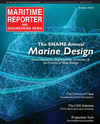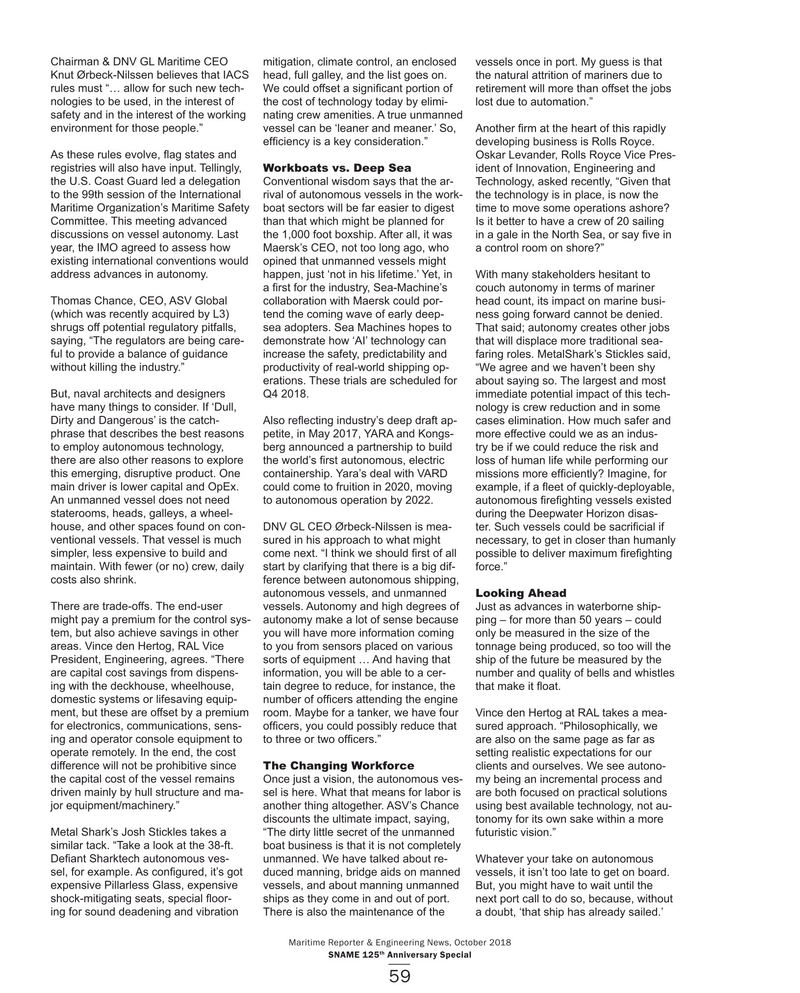
Page 59: of Maritime Reporter Magazine (October 2018)
Marine Design Annual
Read this page in Pdf, Flash or Html5 edition of October 2018 Maritime Reporter Magazine
Chairman & DNV GL Maritime CEO mitigation, climate control, an enclosed vessels once in port. My guess is that
Knut Ørbeck-Nilssen believes that IACS head, full galley, and the list goes on. the natural attrition of mariners due to rules must “… allow for such new tech- We could offset a signi? cant portion of retirement will more than offset the jobs nologies to be used, in the interest of the cost of technology today by elimi- lost due to automation.” safety and in the interest of the working nating crew amenities. A true unmanned environment for those people.” vessel can be ‘leaner and meaner.’ So, Another ? rm at the heart of this rapidly ef? ciency is a key consideration.” developing business is Rolls Royce.
As these rules evolve, ? ag states and Oskar Levander, Rolls Royce Vice Pres- registries will also have input. Tellingly, Workboats vs. Deep Sea ident of Innovation, Engineering and the U.S. Coast Guard led a delegation Conventional wisdom says that the ar- Technology, asked recently, “Given that to the 99th session of the International rival of autonomous vessels in the work- the technology is in place, is now the
Maritime Organization’s Maritime Safety boat sectors will be far easier to digest time to move some operations ashore?
Committee. This meeting advanced than that which might be planned for Is it better to have a crew of 20 sailing discussions on vessel autonomy. Last the 1,000 foot boxship. After all, it was in a gale in the North Sea, or say ? ve in year, the IMO agreed to assess how Maersk’s CEO, not too long ago, who a control room on shore?” existing international conventions would opined that unmanned vessels might address advances in autonomy. happen, just ‘not in his lifetime.’ Yet, in With many stakeholders hesitant to a ? rst for the industry, Sea-Machine’s couch autonomy in terms of mariner
Thomas Chance, CEO, ASV Global collaboration with Maersk could por- head count, its impact on marine busi- (which was recently acquired by L3) tend the coming wave of early deep- ness going forward cannot be denied. shrugs off potential regulatory pitfalls, sea adopters. Sea Machines hopes to That said; autonomy creates other jobs saying, “The regulators are being care- demonstrate how ‘AI’ technology can that will displace more traditional sea- ful to provide a balance of guidance increase the safety, predictability and faring roles. MetalShark’s Stickles said, without killing the industry.” productivity of real-world shipping op- “We agree and we haven’t been shy erations. These trials are scheduled for about saying so. The largest and most
But, naval architects and designers Q4 2018. immediate potential impact of this tech- have many things to consider. If ‘Dull, nology is crew reduction and in some
Dirty and Dangerous’ is the catch- Also re? ecting industry’s deep draft ap- cases elimination. How much safer and phrase that describes the best reasons petite, in May 2017, YARA and Kongs- more effective could we as an indus- to employ autonomous technology, berg announced a partnership to build try be if we could reduce the risk and there are also other reasons to explore the world’s ? rst autonomous, electric loss of human life while performing our this emerging, disruptive product. One containership. Yara’s deal with VARD missions more ef? ciently? Imagine, for main driver is lower capital and OpEx. could come to fruition in 2020, moving example, if a ? eet of quickly-deployable,
An unmanned vessel does not need to autonomous operation by 2022. autonomous ? re? ghting vessels existed staterooms, heads, galleys, a wheel- during the Deepwater Horizon disas- house, and other spaces found on con- DNV GL CEO Ørbeck-Nilssen is mea- ter. Such vessels could be sacri? cial if ventional vessels. That vessel is much sured in his approach to what might necessary, to get in closer than humanly simpler, less expensive to build and come next. “I think we should ? rst of all possible to deliver maximum ? re? ghting maintain. With fewer (or no) crew, daily start by clarifying that there is a big dif- force.” costs also shrink. ference between autonomous shipping, autonomous vessels, and unmanned Looking Ahead
There are trade-offs. The end-user vessels. Autonomy and high degrees of Just as advances in waterborne ship- might pay a premium for the control sys- autonomy make a lot of sense because ping – for more than 50 years – could tem, but also achieve savings in other you will have more information coming only be measured in the size of the areas. Vince den Hertog, RAL Vice to you from sensors placed on various tonnage being produced, so too will the
President, Engineering, agrees. “There sorts of equipment … And having that ship of the future be measured by the are capital cost savings from dispens- information, you will be able to a cer- number and quality of bells and whistles ing with the deckhouse, wheelhouse, tain degree to reduce, for instance, the that make it ? oat.
domestic systems or lifesaving equip- number of of? cers attending the engine ment, but these are offset by a premium room. Maybe for a tanker, we have four Vince den Hertog at RAL takes a mea- for electronics, communications, sens- of? cers, you could possibly reduce that sured approach. “Philosophically, we ing and operator console equipment to to three or two of? cers.” are also on the same page as far as operate remotely. In the end, the cost setting realistic expectations for our difference will not be prohibitive since The Changing Workforce clients and ourselves. We see autono- the capital cost of the vessel remains Once just a vision, the autonomous ves- my being an incremental process and driven mainly by hull structure and ma- sel is here. What that means for labor is are both focused on practical solutions jor equipment/machinery.” another thing altogether. ASV’s Chance using best available technology, not au- discounts the ultimate impact, saying, tonomy for its own sake within a more
Metal Shark’s Josh Stickles takes a “The dirty little secret of the unmanned futuristic vision.” similar tack. “Take a look at the 38-ft. boat business is that it is not completely
De? ant Sharktech autonomous ves- unmanned. We have talked about re- Whatever your take on autonomous sel, for example. As con? gured, it’s got duced manning, bridge aids on manned vessels, it isn’t too late to get on board. expensive Pillarless Glass, expensive vessels, and about manning unmanned But, you might have to wait until the shock-mitigating seats, special ? oor- ships as they come in and out of port. next port call to do so, because, without ing for sound deadening and vibration There is also the maintenance of the a doubt, ‘that ship has already sailed.’
Maritime Reporter & Engineering News, October 2018 th
SNAME 125 Anniversary Special 59
MR #10 (58-65).indd 59 MR #10 (58-65).indd 59 10/5/2018 10:54:14 AM10/5/2018 10:54:14 AM

 58
58

 60
60
